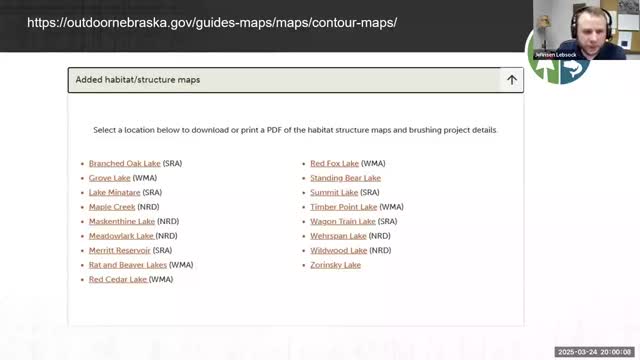Wildlife District conducts sonar study recruiting anglers for seasonal research
January 01, 2025 | Nebraska Game and Parks Commission (NGPC), State Agencies, Organizations, Executive, Nebraska
This article was created by AI summarizing key points discussed. AI makes mistakes, so for full details and context, please refer to the video of the full meeting. Please report any errors so we can fix them. Report an error »

In a gathering marked by enthusiasm and a shared commitment to Nebraska's aquatic resources, the Southeast District Fisheries Meeting 2025 unfolded with a focus on community engagement and scientific research. As participants settled into their seats, the atmosphere buzzed with anticipation for the insights that would be shared.
The meeting kicked off with a reminder of the wealth of information available on the Nebraska Game and Parks Commission (NGPC) website. Attendees were encouraged to utilize the online resources, including structure and contour maps, which are vital for anglers seeking to enhance their fishing experiences. The presenters emphasized the importance of staying connected, sharing their contact information and inviting questions from the fishing community. “We’re here to assist you anglers,” one speaker noted, reinforcing the district staff's commitment to providing support and information.
A highlight of the meeting was the introduction of a new team member, Coy, who brings a wealth of experience from his studies at Iowa State and his work in Wyoming and Minnesota. His addition to the team was met with optimism, as attendees looked forward to the fresh perspectives he would bring to Nebraska's fisheries.
The discussion then shifted to a significant sonar study aimed at understanding fish behavior across different seasons. Participants were informed that the study would require a commitment of at least eight days of fishing over various seasons, including late summer, fall, winter, and spring. This research is designed to gather crucial data that could enhance fishing practices and conservation efforts. Interested volunteers were encouraged to reach out for more details, highlighting the collaborative spirit of the meeting.
As the session wrapped up, the presenters reiterated their eagerness to engage with the community, promising to follow up with additional resources and information via email. The meeting not only served as a platform for sharing knowledge but also fostered a sense of community among anglers and fisheries staff, all dedicated to the stewardship of Nebraska's waters. With a commitment to ongoing dialogue and research, the future of fishing in the region looks promising.
The meeting kicked off with a reminder of the wealth of information available on the Nebraska Game and Parks Commission (NGPC) website. Attendees were encouraged to utilize the online resources, including structure and contour maps, which are vital for anglers seeking to enhance their fishing experiences. The presenters emphasized the importance of staying connected, sharing their contact information and inviting questions from the fishing community. “We’re here to assist you anglers,” one speaker noted, reinforcing the district staff's commitment to providing support and information.
A highlight of the meeting was the introduction of a new team member, Coy, who brings a wealth of experience from his studies at Iowa State and his work in Wyoming and Minnesota. His addition to the team was met with optimism, as attendees looked forward to the fresh perspectives he would bring to Nebraska's fisheries.
The discussion then shifted to a significant sonar study aimed at understanding fish behavior across different seasons. Participants were informed that the study would require a commitment of at least eight days of fishing over various seasons, including late summer, fall, winter, and spring. This research is designed to gather crucial data that could enhance fishing practices and conservation efforts. Interested volunteers were encouraged to reach out for more details, highlighting the collaborative spirit of the meeting.
As the session wrapped up, the presenters reiterated their eagerness to engage with the community, promising to follow up with additional resources and information via email. The meeting not only served as a platform for sharing knowledge but also fostered a sense of community among anglers and fisheries staff, all dedicated to the stewardship of Nebraska's waters. With a commitment to ongoing dialogue and research, the future of fishing in the region looks promising.
View full meeting
This article is based on a recent meeting—watch the full video and explore the complete transcript for deeper insights into the discussion.
View full meeting
